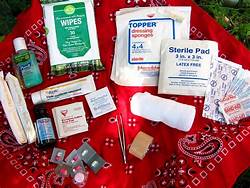One of the most important pieces of gear for anybody who likes to leave the pavement is a solid first-aid kit. Whether you are heading into the deep stuff for a multi-day hunt or simply hitting your local standsite while setting trail cams, a first-aid should always be in your pack. Never assume the outfitter, your hunting buddy or someone else along the trail will have a medical kit, so always be ready to take care of yourself.
I can promise you folks, toting a first-aid kit is always a good idea, but just as important is knowing how to use the kit. Do yourself a favor and take a basic first-aid and CPR class, which can be arranged at the local county health department. If you know any first responders, talk to them and inquire about tips and techniques to employ in an emergency. In the heat of the moment, that knowledge is crucial; whether it’s yourself or somebody else that’s injured. In the least, you can find first aid tutorials on YouTube to help you be prepared. The point is, learn the skills to get yourself or anybody else home safely, no matter what you encounter out there beyond the beaten path.
My personal kit holds the basics for dressing small wounds and minimal medications on hand for cuts, scrapes, blisters and the lot, while remaining portable enough to slot easily into a pocket on my daypack. A larger kit remains in my truck all of the time and includes meds, gauze sponges, band-aids, butterfly bandages, prep pads, tweezers, antibiotic cream, nitrile gloves, duct tape, towelettes, a Sharpie marker, a space blanket, Super Glue and an extra pocket knife.
Meds, I mentioned above that I carry some in my kit. All over the counter, but with a purpose. Benadryl tabs I keep on hand for possible allergic reactions. Ibuprofen for headaches, backaches, body aches, fever…. you name it. Antacid tabs for heartburn or indigestion from too much camp chili as well as Immodium for another morning after malady camp chili is famous for! A good med to keep on hand, Bayer children’s aspirin; I hunt with a lot of older fellas and first symptoms of a heart attack, I’m shoving it at them. I store meds into their own, labeled baggie in my kit and keep an eye on expiration dates.
At the beginning of every trip, talk with your buddies and ensure they know you have a kit and what’s in it. Some people may need fast access to particular medications and it’s important to know who has what gear and where it is. And while this list is in no way intended to be a final or complete guide, use it as a starting point to review your own first-aid practices in the field.
If something were to happen, are you prepared?
I can’t tell you how much I appreciate hearing from so many of you each week. I surely thank you for all of your input and as always, if you have any feedback, give me a shout at [email protected]. God Bless and Good Hunting!

